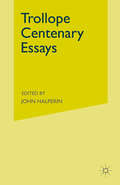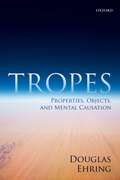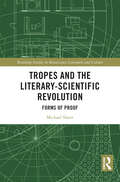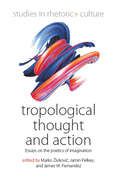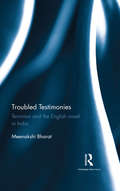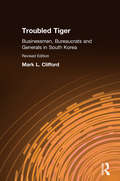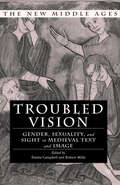- Table View
- List View
The Troll Inside You (PDF): Paranormal Activity In The Medieval North
by Ármann JakobssonNo synopsis available.
Trollope and the Church of England
by Jill DureyTrollope and the Church of England is the first detailed examination of Trollope's attitude towards his Anglican faith and the Church, and the impact this had on his works. Durey controversially explodes the myth that Trollope's most popular characters just happened to be clerical and were simply a skit on the Church, by revealing the true extent of his lifelong fascination with religion.
Trollope and the Magazines: Gendered Issues in Mid-Victorian Britain
by M. TurnerTrollope and the Magazines examines the serial publication of several of Trollope's novels in the context of the gendered discourses in a range of Victorian magazines - including Cornhill, Good Words, Saint Pauls , and the Fortnightly Review . It highlights the importance of the periodical press in the literary culture of Victorian Britain, and argues that readers today need to engage with the lively cultural debates in the magazines, in order better to appreciate the complexity of Trollope's popular fiction.
A Trollope Chronology (Author Chronologies Series)
by R.C. TerryAnthony Trollope was a Post Office surveyor, writer, editor and world traveller. This chronology combines factual details with comment and anecdote from his wide contacts and includes brief accounts of his published works and reactions to them.
Tropes: Properties, Objects, And Mental Causation
by Douglas EhringProperties and objects are everywhere. We cannot take a step without walking into them; we cannot construct a theory in science without referring to them. Given their ubiquitous character, one might think that there would be a standard metaphysical account of properties and objects, but they remain a philosophical mystery. Douglas Ehring presents a defense of tropes—properties and relations understood as particulars—and of trope bundle theory as the best accounts of properties and objects, and advocates a specific brand of trope nominalism, Natural Class Trope Nominalism. This position rejects the existence of universals, and holds that the nature of each individual trope is determined by its membership in various natural classes of tropes (in contrast with the view that a trope's nature is logically prior to those class memberships). The first part of the book provides a general introduction and defense of tropes and trope bundle theory. Ehring demonstrates that there are tropes and indicates some of the things that tropes can do for us metaphysically, including helping to solve the problems of mental causation, while remaining neutral between different theories of tropes. In the second part he offers a more specific defense of Natural Class Trope Nominalism, and provides a full analysis of what a trope is.
Tropes and the Literary-Scientific Revolution: Forms of Proof (Routledge Studies in Renaissance Literature and Culture)
by Michael SlaterTropes and the Literary-Scientific Revolution: Forms of Proof argues that the rise of mechanical science in the seventeenth century had a profound impact on both language and literature. To the extent that new ideas about things were accompanied by new attitudes toward words, what we commonly regard as the “scientific revolution” inevitably bore literary dimensions as well. Literary tropes and forms underwent tremendous reassessment in the seventeenth century, and early modern science was shaped just as powerfully by contest over the place of literary figures, from personification and metaphor to anamorphosis and allegory. In their rejection of teleological explanations of natural motion, for instance, early modern philosophers often disputed the value of personification, a figural projection of interiority onto what was becoming increasingly a mechanical world. And allegory—a dominant mode of literature from the late Middle Ages until well into the Renaissance—became “the vice of those times,” as Thomas Rymer described it in 1674. This book shows that its acute devaluation was possible only in conjunction with a distinctively modern physics. Analyzing writings by Sidney, Shakespeare, Bacon, Jonson, Brahe, Kepler, Galileo, Hobbes, Descartes, and more, it asserts that the scientific revolution was a literary phenomenon, just as the literary revolution was also a scientific one.
Tropes and the Literary-Scientific Revolution: Forms of Proof (Routledge Studies in Renaissance Literature and Culture)
by Michael SlaterTropes and the Literary-Scientific Revolution: Forms of Proof argues that the rise of mechanical science in the seventeenth century had a profound impact on both language and literature. To the extent that new ideas about things were accompanied by new attitudes toward words, what we commonly regard as the “scientific revolution” inevitably bore literary dimensions as well. Literary tropes and forms underwent tremendous reassessment in the seventeenth century, and early modern science was shaped just as powerfully by contest over the place of literary figures, from personification and metaphor to anamorphosis and allegory. In their rejection of teleological explanations of natural motion, for instance, early modern philosophers often disputed the value of personification, a figural projection of interiority onto what was becoming increasingly a mechanical world. And allegory—a dominant mode of literature from the late Middle Ages until well into the Renaissance—became “the vice of those times,” as Thomas Rymer described it in 1674. This book shows that its acute devaluation was possible only in conjunction with a distinctively modern physics. Analyzing writings by Sidney, Shakespeare, Bacon, Jonson, Brahe, Kepler, Galileo, Hobbes, Descartes, and more, it asserts that the scientific revolution was a literary phenomenon, just as the literary revolution was also a scientific one.
Tropical Gothic in Literature and Culture: The Americas (Routledge Interdisciplinary Perspectives on Literature)
by Justin D. Edwards Sandra G. T. VasconcelosTropical Gothic examines Gothic within a specific geographical area of ‘the South’ of the Americas. In so doing, we structure the book around geographical coordinates (from North to South) and move between various national traditions of the gothic (Mexico, Argentina, Brazil, etc) alongside regional manifestations of the Gothic (the US south and the Caribbean) as well as transnational movements of the Gothic within the Americas. The reflections on national traditions of the Gothic in this volume add to the critical body of literature on specific languages or particular nations, such as Scottish Gothic, American Gothic, Canadian Gothic, German Gothic, Kiwi Gothic, etc. This is significant because, while the Southern Gothic in the US has been thoroughly explored, there is a gap in the critical literature about the Gothic in the larger context of region of ‘the South’ in the Americas. This volume does not pretend to be a comprehensive examination of tropical Gothic in the Americas; rather, it pinpoints a variety of locations where this form of the Gothic emerges. In so doing, the transnational interventions of the Gothic in this book read the flows of Gothic forms across borders and geographical regions to tease out the complexities of Gothic cultural production within cultural and linguistic translations. Tropical Gothic includes, but is by no means limited to, a reflection on a region where European colonial powers fought intensively against indigenous populations and against each other for control of land and resources. In other cases, the vast populations of African slaves were transported, endowing these regions with a cultural inheritance that all the nations involved are still trying to comprehend. The volume reflects on how these histories influence the Gothic in this region.
Tropical Gothic in Literature and Culture: The Americas (Routledge Interdisciplinary Perspectives on Literature)
by Justin D. Edwards Sandra Guardini VasconcelosTropical Gothic examines Gothic within a specific geographical area of ‘the South’ of the Americas. In so doing, we structure the book around geographical coordinates (from North to South) and move between various national traditions of the gothic (Mexico, Argentina, Brazil, etc) alongside regional manifestations of the Gothic (the US south and the Caribbean) as well as transnational movements of the Gothic within the Americas. The reflections on national traditions of the Gothic in this volume add to the critical body of literature on specific languages or particular nations, such as Scottish Gothic, American Gothic, Canadian Gothic, German Gothic, Kiwi Gothic, etc. This is significant because, while the Southern Gothic in the US has been thoroughly explored, there is a gap in the critical literature about the Gothic in the larger context of region of ‘the South’ in the Americas. This volume does not pretend to be a comprehensive examination of tropical Gothic in the Americas; rather, it pinpoints a variety of locations where this form of the Gothic emerges. In so doing, the transnational interventions of the Gothic in this book read the flows of Gothic forms across borders and geographical regions to tease out the complexities of Gothic cultural production within cultural and linguistic translations. Tropical Gothic includes, but is by no means limited to, a reflection on a region where European colonial powers fought intensively against indigenous populations and against each other for control of land and resources. In other cases, the vast populations of African slaves were transported, endowing these regions with a cultural inheritance that all the nations involved are still trying to comprehend. The volume reflects on how these histories influence the Gothic in this region.
Tropics of Vienna: Colonial Utopias of the Habsburg Empire (Austrian and Habsburg Studies #19)
by Ulrich E. BachThe Austrian Empire was not a colonial power in the sense that fellow actors like 19th-century England and France were. It nevertheless oversaw a multinational federation where the capital of Vienna was unmistakably linked with its eastern periphery in a quasi-colonial arrangement that inevitably shaped the cultural and intellectual life of the Habsburg Empire. This was particularly evident in the era’s colonial utopian writing, and Tropics of Vienna blends literary criticism, cultural theory, and historical analysis to illuminate this curious genre. By analyzing the works of Leopold von Sacher-Masoch, Theodor Herzl, Joseph Roth, and other representative Austrian writers, it reveals a shared longing for alternative social and spatial configurations beyond the concept of the “nation-state” prevalent at the time.
Troping Oroonoko from Behn to Bandele
by Susan B. IwanisziwThis volume of essays invites the reader to assess literary texts from within the frame of the texts' cultural history, which includes issues of authorship and literary or stage convention as well as the social and political institutions that shaped and marketed that literature. The collection initiates just such an in-depth and focused analysis of the complex literary and social history of the royal slave Oroonoko. All eight essays address elements in the evolution of Oroonoko, from Behn's 1688 novella to Southerne's 1696 dramatic adaptation, and thence to the adaptations by Hawkesworth (1759), Gentleman (1760), Anonymous (1760), Ferriar (1788), Bellamy (1789) and Bandele (1999), who serially expropriated the play as a platform to debate responsibility in matters of slavery and colonialism. Perhaps unique among literary creations, Oroonoko and his entourage, with their distinctive race, class and gender attributes, came into popular consciousness as tropes gauging important shifts in English values during the course of the transatlantic slave trade. Accordingly, this study aims to provide a specific exemplum of rigorous, focused research on a single, complex and controversial topic but also to complicate some of our received notions about Oroonoko, slavery and abolition with a view to encouraging a more rigorous analysis of the cultural history underpinning literary texts. .
Troping Oroonoko from Behn to Bandele
by Susan B. IwanisziwThis volume of essays invites the reader to assess literary texts from within the frame of the texts' cultural history, which includes issues of authorship and literary or stage convention as well as the social and political institutions that shaped and marketed that literature. The collection initiates just such an in-depth and focused analysis of the complex literary and social history of the royal slave Oroonoko. All eight essays address elements in the evolution of Oroonoko, from Behn's 1688 novella to Southerne's 1696 dramatic adaptation, and thence to the adaptations by Hawkesworth (1759), Gentleman (1760), Anonymous (1760), Ferriar (1788), Bellamy (1789) and Bandele (1999), who serially expropriated the play as a platform to debate responsibility in matters of slavery and colonialism. Perhaps unique among literary creations, Oroonoko and his entourage, with their distinctive race, class and gender attributes, came into popular consciousness as tropes gauging important shifts in English values during the course of the transatlantic slave trade. Accordingly, this study aims to provide a specific exemplum of rigorous, focused research on a single, complex and controversial topic but also to complicate some of our received notions about Oroonoko, slavery and abolition with a view to encouraging a more rigorous analysis of the cultural history underpinning literary texts. .
Tropological Thought and Action: Essays on the Poetics of Imagination (Studies in Rhetoric and Culture #9)
by Jamin Pelkey Marko Živković James W. FernandezFrom twilight in the Himalayas to dream worlds in the Serbian state, this book provides a unique collection of anthropological and cross-cultural inquiry into the power of rhetorical tropes and their relevance to the formation and analysis of social thought and action through a series of ethnographic essays offering in-depth studies of the human imagination at work and play around the world.
The Trouble with Literature (Clarendon Lectures in English)
by Victoria KahnThis book, based on the Clarendon Lectures in English for 2017, argues that the literature of the English Reformation marks a turning point in Western thinking about literature and literariness. But instead of arguing that the Reformation fostered English literature, as scholars have often done, Victoria Kahn claims that literature helped undo the Reformation, with implications for both poetry and belief. Ultimately, literature in the Reformation is one vehicle by which religious belief was itself transformed into a human artifact, whether we understand this as a poetic artifact or a mental fiction. This transformation in turn helped produce the eighteenth-century discipline of aesthetics, with its emphasis on our experience of non-cognitive pleasure in the work of art, and the modern formalist definition of literature, according to which—in the words of one critic—'literature solves no problems and saves no souls.' This modern definition of literature, in short, has a history, this history is intertwined with the problem of belief, and by returning to the fraught years of the late sixteenth and seventeenth century in England, we can come to a new understanding of how the trouble with literature has shaped our discipline. The first lecture contrasts modern and early modern understandings of literature and literariness. The second and third lectures focus on Thomas Hobbes and John Milton. The fourth lecture treats the work of Immanuel Kant, Søren Kierkegaard, and J.M. Coetzee.
The Trouble with Literature (Clarendon Lectures in English)
by Victoria KahnThis book, based on the Clarendon Lectures in English for 2017, argues that the literature of the English Reformation marks a turning point in Western thinking about literature and literariness. But instead of arguing that the Reformation fostered English literature, as scholars have often done, Victoria Kahn claims that literature helped undo the Reformation, with implications for both poetry and belief. Ultimately, literature in the Reformation is one vehicle by which religious belief was itself transformed into a human artifact, whether we understand this as a poetic artifact or a mental fiction. This transformation in turn helped produce the eighteenth-century discipline of aesthetics, with its emphasis on our experience of non-cognitive pleasure in the work of art, and the modern formalist definition of literature, according to which—in the words of one critic—'literature solves no problems and saves no souls.' This modern definition of literature, in short, has a history, this history is intertwined with the problem of belief, and by returning to the fraught years of the late sixteenth and seventeenth century in England, we can come to a new understanding of how the trouble with literature has shaped our discipline. The first lecture contrasts modern and early modern understandings of literature and literariness. The second and third lectures focus on Thomas Hobbes and John Milton. The fourth lecture treats the work of Immanuel Kant, Søren Kierkegaard, and J.M. Coetzee.
Troubled Testimonies: Terrorism and the English novel in India
by Meenakshi BharatSince the 9/11 attacks terror has established its permeating hold on society’s psyche. Creative writing, a popular and visible cultural witness to the strain, has taken up this destabilization with remarkable regularity. Troubled Testimonies focuses on the Indian novel in English, deriving inspiration from these disturbances, to essay a unique grasp of the cultural make-up of the times and its reverberations on the sense of self and belonging to the nation. This first full-length study of terror in the subcontinental novel in English (from India) places it in the world context and analyzes the fictional coverage of the spread of terrorism across the country and its cultural fallout. The enigmatic coming together of the contemporary with the anguish of loss and betrayal unleashed by terror occasions a significant redefinition of the issues of trauma, conflict and gender, and opens a fresh window to Indian writing and the culture of the subcontinent, and a new paradigm in literary and cultural criticism termed ‘post-terrorism’. Lucid and thought provoking, this book will be useful to scholars and researchers of South Asian literature, cultural studies, postcolonial studies, history, politics and sociology.
Troubled Testimonies: Terrorism and the English novel in India
by Meenakshi BharatSince the 9/11 attacks terror has established its permeating hold on society’s psyche. Creative writing, a popular and visible cultural witness to the strain, has taken up this destabilization with remarkable regularity. Troubled Testimonies focuses on the Indian novel in English, deriving inspiration from these disturbances, to essay a unique grasp of the cultural make-up of the times and its reverberations on the sense of self and belonging to the nation. This first full-length study of terror in the subcontinental novel in English (from India) places it in the world context and analyzes the fictional coverage of the spread of terrorism across the country and its cultural fallout. The enigmatic coming together of the contemporary with the anguish of loss and betrayal unleashed by terror occasions a significant redefinition of the issues of trauma, conflict and gender, and opens a fresh window to Indian writing and the culture of the subcontinent, and a new paradigm in literary and cultural criticism termed ‘post-terrorism’. Lucid and thought provoking, this book will be useful to scholars and researchers of South Asian literature, cultural studies, postcolonial studies, history, politics and sociology.
Troubled Tiger: Businessmen, Bureaucrats and Generals in South Korea
by Mark L. CliffordThis analysis of modern Korea includes: the imprisonment and sentencing of two former presidents of South Korea for their role in the Kwangju uprising and on various charges of corruption; the death of Kim II Sung and the resultant North-South standoff; and recent labour and student protests.
Troubled Tiger: Businessmen, Bureaucrats and Generals in South Korea
by Mark L. CliffordThis analysis of modern Korea includes: the imprisonment and sentencing of two former presidents of South Korea for their role in the Kwangju uprising and on various charges of corruption; the death of Kim II Sung and the resultant North-South standoff; and recent labour and student protests.
Troubled Vision: Gender, Sexuality and Sight in Medieval Text and Image (The New Middle Ages)
by E. Campbell R. MillsTroubled Vision is an interdisciplinary collection of essays that explores the interface between gender, sexuality and vision in medieval culture. The volume represents an exciting array of scholarship dealing with visual and textual cultures from the Eleventh to the Fifteenth centuries. Bringing together a range of theoretical approaches that address the troubling effects of vision on medieval texts and images, the book mediates between medieval and modern constructions of gender and sexuality. Troubled Vision focuses thematically on four central themes: Desire, looking, representation and reading. Topics include the gender of the gaze, the visibility of queer desires, troubled representations of gender and sexuality, spectacle and reader response, and the visual troubling of modern critical categories.





